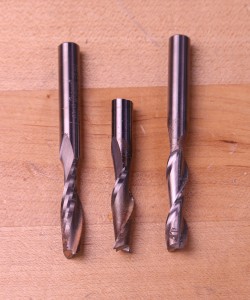We may receive a commission when you use our affiliate links. However, this does not impact our recommendations.

Down with the upcut. Spiral upcut bits are useful in lots of instances, but are more expensive and not as versatile as straight bits. For this reason I recommend adding them to your core set if, and when, you need them.
In the November issue of Popular Woodworking Magazine I wrote an article outlining the router bits I consider to be the core of any powered shop. The workhorse bits of that core set are the straight bits.
Straight router bits come in three varieties: Spiral-upcut, spiral-downcut and straight-cut bits. The choice of which to use comes down to the specific job and your preferences.
The difference between straight and spiral bits is not only the helical shape of the cutting surface, but also how they function. With a helical shape, you get a shearing cut, which leaves the surface smoother with less tear-out. They’re great for trimming surfaces of highly-figured woods.
A straight bit planes squarely across the surface of the wood, which makes its cuts subject to greater tear-out. Also, because a straight bit strikes the surface of the wood perpendicular to the direction of rotation, you’ll also get more chatter. A spiral bit stays in constant contact with the surface, resulting in less chatter.
You can use the helical design of spiral-upcut bits to help hold the router and the work in position. The force from the cutting action tends to draw the router and workpiece tighter together. With a little creative thinking, you can use this action to hide potential tear-out or hold the router tight to a pattern on a piece where a straight cutter might leave things feeling less than stable.
Spiral-downcut bits have the reverse effect, pushing the router and the work apart. This may not sound like an advantage, but when trimming or grooving a veneered surface, the down-cut bit causes less lifting and tear-out of the veneer.
It might sound like I am suggesting you only have spiral bits in your core group; I am not. In fact, none of the bits in my core set are spiral bits. I think they have their uses, but they are considerably more expensive and, in my opinion, not necessarily the best choice for every job.
The spiral nature of the bits makes removing larger amounts of waste a more tedious and laborious job. I’ve found you just can’t take as deep a cut with them as you can straight bits; I own just a few spiral bits and I use them sparingly.
For more on what I consider to be my core set of router bits, and why, check out the November 2014 issue arriving in your mailbox soon. Not a subscriber? You can fix that by clicking here.
Here are some supplies and tools we find essential in our everyday work around the shop. We may receive a commission from sales referred by our links; however, we have carefully selected these products for their usefulness and quality.









“Straight router bits come in three varieties: Spiral-upcut, spiral-downcut and straight-cut bits”. There are actually four varieties as you forgot about the compression bit that combines the up-cut and down-cut helical cutting edges to give a lovely edge when trimming double sided laminate. One of the big advantages of an up-cut router bit is for mortising.
I have heard that spiral bits are more prone to snap off when used to make a plunge cut. Is this true?
Great info as usual from Chuck.
A fellow woodworker with a day job as a machinist turned me on end mills as an option. You get a much greater selection of shear geometries, number of flutes, length of bits and cutting lengths, but are far less costly than spiral “router” bits. I paid $25 for a 1/2″ D 2 flute carbide end mill instead of $70 for a freud bit with the same specs…
I’ve still got my straight bits when a task calls for a bottom piloted bearing bit, but for anything I can use a pattern bit (bearing toward the collet) I throw in a spiral bit and run the shank of the bit on the pattern.